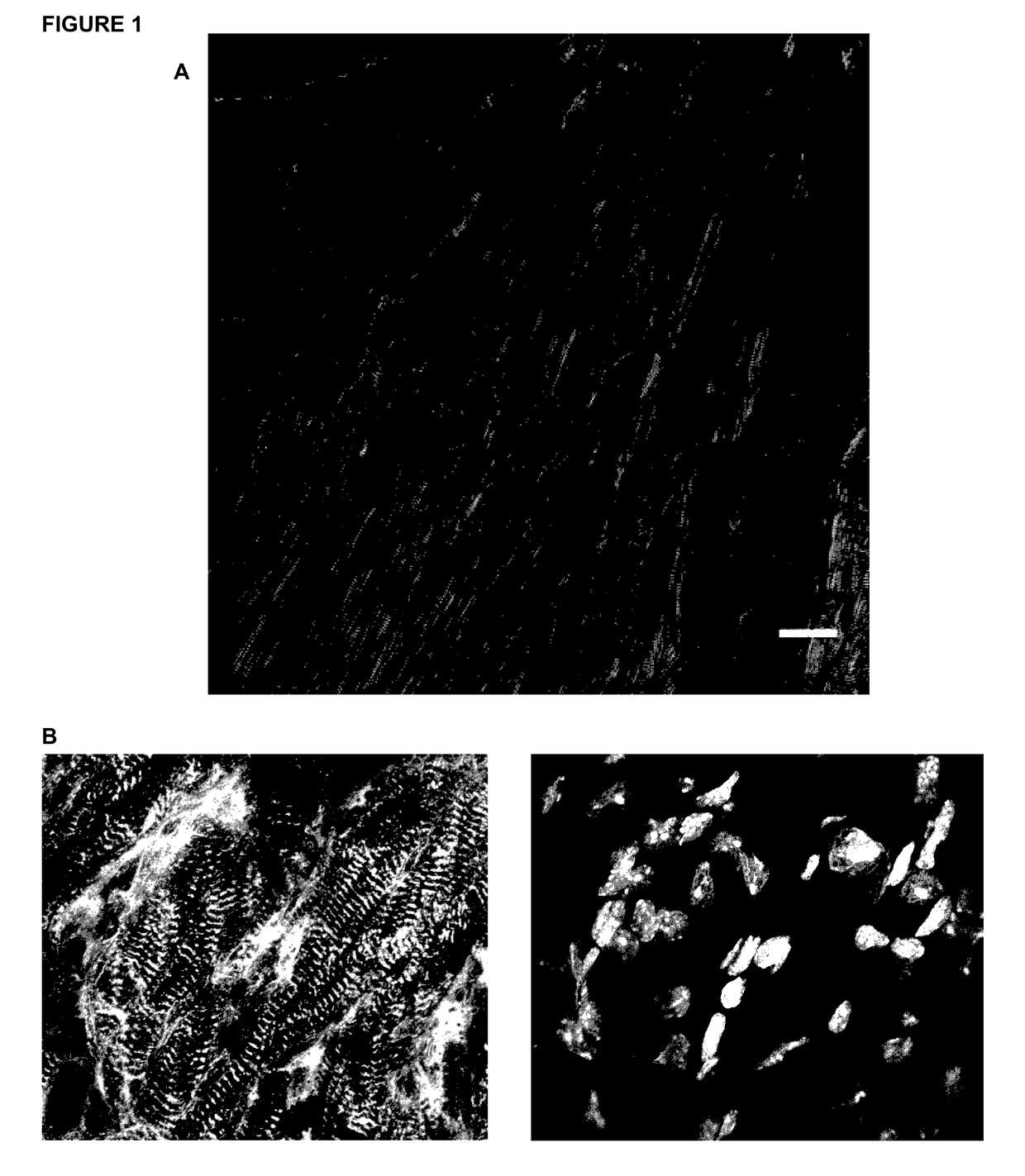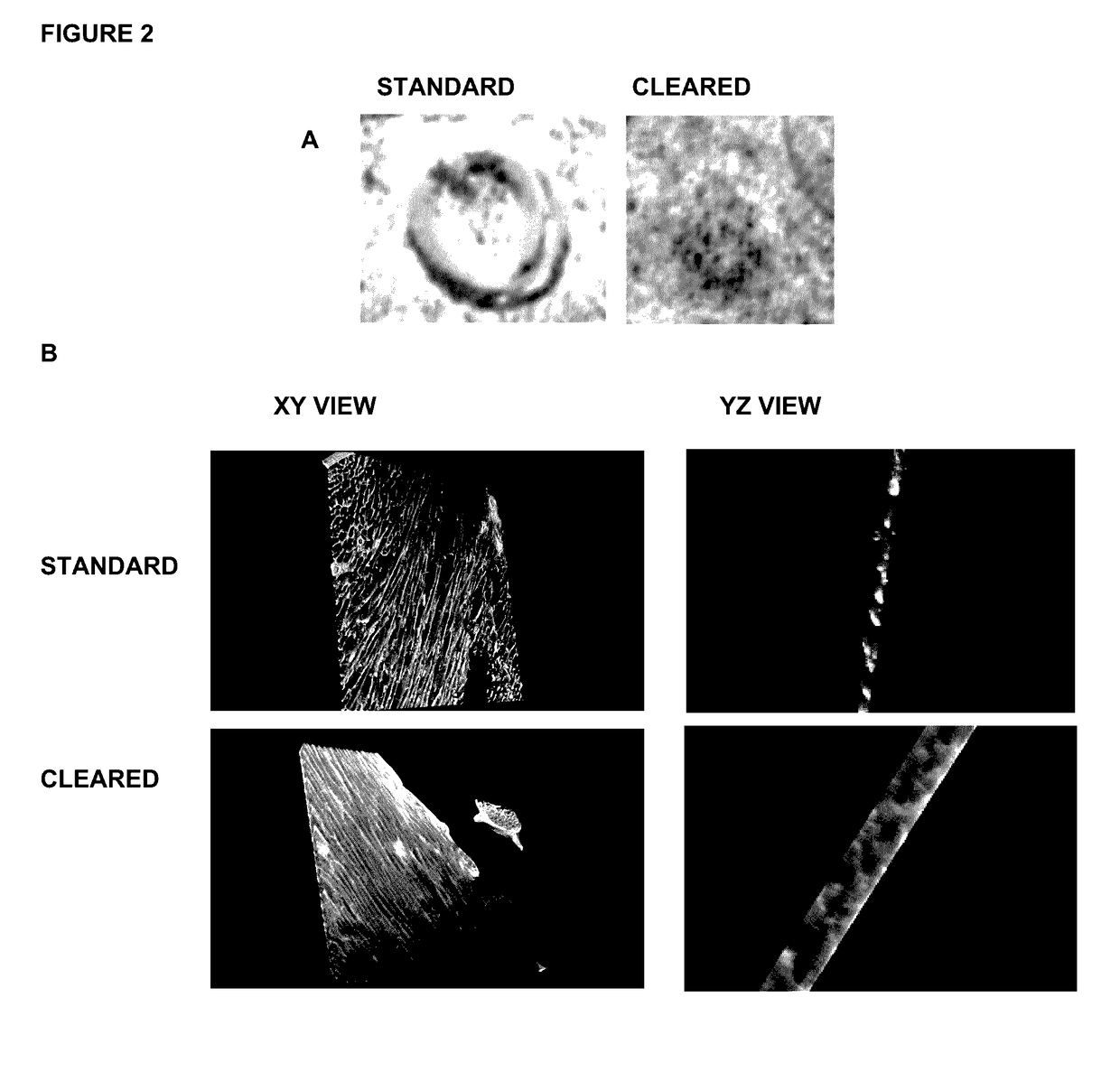High-resolution three-dimensional imaging of mammalian hearts
a three-dimensional imaging and heart technology, applied in image enhancement, instruments, image data processing, etc., can solve the problems of limiting the type of information that can be gained, the final specimen may not reflect well, and the information regarding the cell context in the organ is los
- Summary
- Abstract
- Description
- Claims
- Application Information
AI Technical Summary
Benefits of technology
Problems solved by technology
Method used
Image
Examples
example 1
lution Three-Dimensional Cardiac Imaging
[0068]In this work we established a sample preparation method that utilizes vibratorne sectioning, tissue clearing, and confocal microscopy techniques. We generated 3D images of adult mammalian hearts with 0.2 μm resolution in xy and 0.3 μm resolution in yz / xz, spanning several cardiac myocytes of thickness, in native tissue. We used this innovation to assess fibrosis and sarcomere disarray in human ischemic heart disease samples and to obtain volumetric quantification of mitotic activity, apoptosis, and chromatin subnuclear structure in adult mouse cardiac myocytes,
[0069]We followed established conventional protocols for imaging paraffin sections and cryosections, Hearts for paraffin sections were fixed with 4% PFA and sectioned at 4 μm thiCkneSS. Fresh hearts were frozen in OCT medium, cryosectioned at 10 μm thickness, and fixed with 100% methanol prior to staining, For High-Resolution Three-Dimensional Cardiac Imaging, we tested various fix...
example 2
rt Preparation
[0070]Obtain human tissue. We used IRB approved LVAD core from patient with ischemic heart disease, keeping fresh sample in a cold, high potassium buffer to keep the myocytes arrested, such as KB buffer.
[0071]Transfer tissue to glass plate, with scalpel, trim heart piece into a cube, ˜3 mm×3 mm×3 mm, keeping sample on ice. *Note, larger pieces do not section well.
[0072]Fix tissue (Choose fix appropriate for downstream applications, other fixatives may be used):
[0073]Transferring sample to 4% paraformaldehyde in PBS, precooled to 4 C. Incubate overnight at 4 C.
OR
[0074]100% methanol (MeOH), precooled to −20 C. Incubate at −20 C for 30 min to 1 hr. In a stepwise manner, incubate the sample in precooled 80% MeOH / 20% PBS, 60% MeOH / 40% PBS, with each incubation for 30 minutes at −20 C.
[0075]Wash 3× with PBS, keep in PBS at 4 C until embedding.
example 3
rt Preparation
[0076]Euthanize animal as approved on animal protocol, according to government and insfitute guidelines, we used isoflurane overdose. Collect heart in cold KB buffer.
[0077](Optional, but recommended) Cannulate aorta with blunt 26 g needle, secure with suture:
[0078]Perfuse 4 ml KB buffer, precooled at 4 C, 2 mL / min to wash the blood out of the coronary vessels.
[0079]Perfuse Fixative:
[0080]4 mL 4% PFA, 4 C, 2 mL / min
OR
[0081]2 mL 100% MeOH, −20 C, 1 mL / min
[0082]Fix Tissue:
[0083]Transfer sample to 4% paraformaldehyde in PBS, precooled to 4 C. Incubate 16 hrs at 4 C.
[0084]100% methanol (MeOH), precooled to −20 C. Incubate at −20 C for 30 min to 1 hr. In a stepwise manner, incubate the sample in precooled 80% MeOH / 120% PBS, 60% MeOH / 40% PBS, with each incubation for 30 minutes at −20 C.
[0085]Wash 3' with PBS, keep in PBS at 4 C until embedding.
PUM
 Login to View More
Login to View More Abstract
Description
Claims
Application Information
 Login to View More
Login to View More - R&D
- Intellectual Property
- Life Sciences
- Materials
- Tech Scout
- Unparalleled Data Quality
- Higher Quality Content
- 60% Fewer Hallucinations
Browse by: Latest US Patents, China's latest patents, Technical Efficacy Thesaurus, Application Domain, Technology Topic, Popular Technical Reports.
© 2025 PatSnap. All rights reserved.Legal|Privacy policy|Modern Slavery Act Transparency Statement|Sitemap|About US| Contact US: help@patsnap.com



